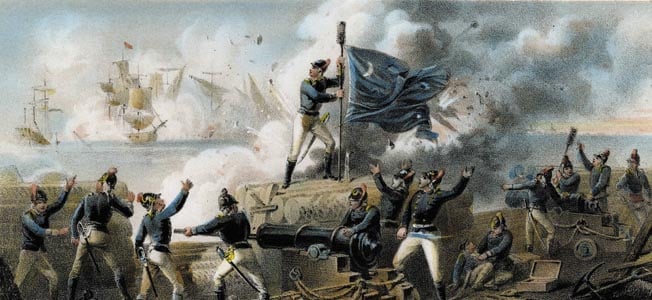Date: June 28, 1776.
Region: Southern Colonies, Charleston, South Carolina.
Opposing Forces: British: 2,900 men (20 ships, 262 guns); American: 425 men (Fort Sullivan: 26 guns, south end of the island), 750 men (north end of the island).
Subscribe to American Military History Podcast
British Perspective: Disappointing setbacks in North Carolina, including the Tory defeat at Moore's Creek Bridge and the loss of the Royal governorship, prompted the British to move their operations to South Carolina, from which colony they launched their Southern Campaign. The British plan was to seize the ports of Savannah, Georgia, and Charleston, South Carolina. After securing the ports and enlisting Tory support, they intended to move aggressively inland and pacify the colonies of South Carolina and Georgia. Once that was complete, Clinton would march north into North Carolina and Virginia and do the same thing. The initial assault against a southern colonial port focused.
American Perspective: Fort Sullivan was the primary Patriot defensive work established to protect the entrance to Charleston harbor. Commanding on Sullivan’s Island was Col. William Moultrie, whose subordinates included future prominent leaders Francis Marion and Thomas Sumter. The commander of the Continental Southern Department, Maj. Gen. Charles Lee arrived at Fort Sullivan on June 2, 1776. In anticipation of the British naval assault, Lee ordered additional fortifications constructed around the city, but there was little else he could do.
Battle of Fort Sullivan Facts: The Fighting
With a favorable wind, Commodore Parker ordered his armada into action at about 10:30 a.m. on June 28. The long-range artillery ship Thunder (bomb ketch with mortar) opened the battle by commencing fire with her 10-inch mortars against Fort Sullivan. The ship was too far away to inflict much damage, and many of the shells buried themselves in the sand or swampy morass inside the fort and exploded with little or no impact. The Thunder was eventually disabled and withdrawn from the action. British warships Bristol, Experiment, Active, Solebay, Acteon, Syren, Sphynx, Friendship, Ranger, and St. Lawrence also went into action, anchoring at various distances and showering the forts with cannon fire. The Acteon, Sphynx, and Syren set sail in an attempt to gain entrance to the harbor along the opposite shore of Fort Sullivan to enfilade the bastion, but luckily for the defenders, all three ran aground on Middle Ground shoal (where Fort Sumter would later be constructed). Syren and Sphynx eventually managed to dislodge themselves and withdraw for repairs. Acteon, however, was caught fast and unable to slip off the bar.
The British poured a relentless fire with more than 100 pieces into Fort Sullivan. However, the stronghold was constructed of sand and spongy palmetto logs, which absorbed the pounding without great difficulty or much damage. Although hampered by a lack of gunpowder, Colonel Moultrie’s artillerists returned fire with deadly accuracy. Commodore Parker’s flagship, Bristol, was struck 70 times and had to be withdrawn from the fight. Moultrie’s fire killed 64 and wounded another 170 on that ship alone. When the sun began setting, the battle fell into a fitful exchange before ending altogether about 9:30 p.m. A stunned Parker ordered his ships to retreat to Five Fathom Hole. The next morning, Acteon was burned to prevent her capture.

To learn more Battle of Fort Sullivan facts, read the book Guide to the Battles of the American Revolution written by Theodore Savas and J. David Dameron.
Battle of Fort Sullivan Facts: Online Resources
- Wikipedia - Battle of Sullivan's Island
- Fort Moultrie - Fort Sumter National Monument
- Library of Congress Collection of Revolutionary War Maps
- West Point Battle Maps of the American Revolution
- Journal of the American Revolution
- Guide to the Battles of the American Revolution
- DIY Genealogy - Finding your Revolutionary War Ancestor
- The History Junkie's Guide to the American Revolutionary War
- The History Junkie's Guide to American Revolutionary War Battles
- The History Junkie’s Guide to the American Revolutionary War Timeline
- The History Junkie’s Guide to the 13 Original Colonies
